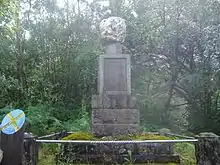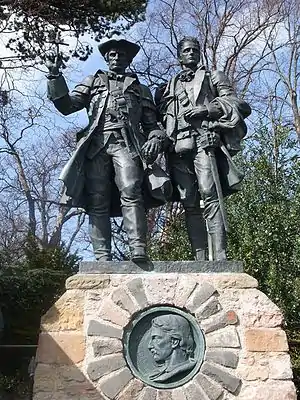Appin Murder
The Appin Murder (Scottish Gaelic: Murt na h-Apainn[1]) was the assassination of Colin Roy Campbell of Glenure on 14 May 1752 near Appin in the west of Scotland. The murder occurred in the aftermath of the Jacobite Rising of 1745 and led to the execution of James Stewart of the Glens, often characterized as a notorious miscarriage of justice.[2] The murder inspired events in Robert Louis Stevenson's 1886 novel Kidnapped. [2]
| Appin Murder | |||||||
|---|---|---|---|---|---|---|---|
| Part of the aftermath of the Jacobite rising of 1745 | |||||||
 Memorial to James Stewart of the Glens who was wrongly convicted and executed for the Appin murder | |||||||
| |||||||
| Belligerents | |||||||
|
|
| ||||||
| Commanders and leaders | |||||||
|
|
| ||||||
| Casualties and losses | |||||||
| Colin Roy Campbell of Glenure killed |
James Stewart executed Allan Stewart exiled | ||||||
Victim

Colin Roy Campbell of Glenure (1708-1752), nicknamed "The Red Fox", was the government-appointed factor to the forfeited lands of the Clan Stewart of Appin in north Argyllshire. During the Highland Clearances, a series of reprisals against Jacobite sympathizers in the aftermath of the rising of 1745, Campbell had ordered several evictions of members of Clan Stewart.[3] On 14 May 1752, Campbell was shot in the back by a marksman in the wood of Lettermore near Duror.[2]
Shortly before his murder, Colin Roy Campbell was mentioned by Jacobite poet Alasdair MacMhaighstir Alasdair in his Anti-Whig satire An Airce. In the poem, the ghost of a beheaded Jacobite who prophesies that his Campbell clansmen will soon be punished for committing high treason against their lawful king. Colin is one the few Whigs for whom the ghost confesses a certain respect:
|
|
Trial
The search for the killer targeted the Clan Stewart. The chief suspect, Alan Breck Stewart having fled, James Stewart of the Glens, the tanist of the Stewarts, was arrested for the crime and tried for the murder[2] in a trial dominated by the pro-Hanoverian Clan Campbell: chief Archibald Campbell, 3rd Duke of Argyll was the presiding judge and the 15-man jury contained Campbell clansmen.[2] Although the trial showed that James was not directly involved in the assassination (he had a solid alibi), he was found guilty "in airts and pairts" (as an accessory; an aider and abetter).[5]
James Stewart was hanged on 8 November 1752 on a specially commissioned gibbet above the narrows at Ballachulish, now near the south entrance to the Ballachulish Bridge. He died protesting his innocence, lamenting that people of the ages may think him capable of a horrid and barbarous murder. Before mounting the scaffold, he sang the 35th Psalm in Scottish Gaelic:
"False witnesses rose; to my charge things I not knew they laid. They, to the spoiling of my soul, me ill for good repaid." ~Psalm 35
To this day in the Highlands, it remains known as "The Psalm of James of the Glens".
James's corpse was left hanging at the south end of the Ballachulish Ferry for eighteen months as a warning to other clans with rebellious intentions. Over those months, it was beaten and battered by winds and rain. As it eventually deteriorated, the skeletal remains were held together with chains and wire. [6]
Recent scholarship
In Walking With Murder: On The Kidnapped Trail (2005), Ian Nimmo has addressed the mystery of who shot Colin Campbell, applying modern police methods to the documents in the case, including two post-mortem reports. According to Nimmo, Alan Stewart did not pull the trigger, and the secret of who did has been handed down through the Stewart family for 250 years. Nimmo chose not to reveal it, stating that "it is not mine to give away".[7]
In 2001, Anda Penman, an 89-year-old descendant of the Clan Chiefs of the Stewarts of Appin, alleged the murder had been planned by four young Stewart tacksmen without the sanction of James of the Glens. There was a shooting contest among them and the assassination was committed by the best marksman among the four, Donald Stewart of Ballachulish.[8][9] According to some accounts, Donald desperately wanted to turn himself in rather than allow James to hang and had to be physically held down to prevent this. Several years after James's execution, when the body was finally delivered to the Stewart Clan for burial, Donald Stewart of Ballachulish was responsible for washing the bones before the funeral.[8]
In his 2004 examination of the evidence, Lee Holcombe also concluded that Donald Stewart, rather than Allan Breck Stewart, was probably the actual shooter.[8][9] However, he also concluded that James of the Glens was indeed guilty of ordering the murder of Colin Campbell.[10]
Recent legal developments
There is a movement afoot to gain a pardon for James of the Glens. In 2008, Glasgow lawyer John Macaulay asked the Scottish Criminal Cases Review Commission to reconsider the case on the grounds his study of the trial transcripts shows there was "not a shred of evidence" against Stewart.[2] but was denied due to the case being so old it was not in the interest of justice.[11] As of 2010, the application lies with the Scottish government.[12]
Notes
- MacIlleathain, Ruairidh (2015). An Creanaiche: myself, Lee Oswald and the murder of JFK. NicEachairne, Màiri (Fictitious character). Dingwall, Ross-shire: Lasag Books. ISBN 978-1-910124-78-9. OCLC 944312200.
- Auslan Cramb (14 November 2008). "18th Century murder conviction 'should be quashed'". The Daily Telegraph.
- Hunter, James; Kennedy, Kate (3 September 2013). "The Appin Murder – Historical Context" (pdf). The Royal Society of Edinburgh. The Royal Society of Edinburgh 2018. Retrieved 29 May 2018.
- Rev. A. MacDonald (1924), The Poems of Alexander MacDonald (Mac Mhaighstir Alasdair) |location=Inverness, Northern Counties Newspaper and Print and Pub. Co. pages=258–261.
- Mackay, David N., ed. (1905–1915). Notable Scottish trials. James Stewart The Appin Murder. Glasgow and Edinburgh: William Hodge & Co. p. 288. OCLC 563059557. Archived from the original on 6 March 2013. Retrieved 14 August 2020.
- "The Appin murder: who killed Red Fox?". news.scotsman.com. The Scotsman. 2005.
- Boztas 2005.
- Lundy 2005.
- McMee 2004.
- Holcombe 2004.
- Commission rules against 18th century murder review, The Journal of the Law Society of Scotland 9 December 2008
- Auslan Cramb (14 November 2008). "18th Century murder conviction 'should be quashed'". The Daily Telegraph.
References
- Boztas, Senay (27 August 2005), "New Appin murder investigation reveals Jacobites plotted to kill", Sunday Herald
- Holcombe, Lee (2004). Ancient Animosity, The Appin Murder and the End of Scottish Rebellion. Bloomington, IN: Author House. ISBN 978-1-4184-2828-0.
- Lundy, Ian (3 October 2005), "The Appin murder: who killed Red Fox?", The Scotsman
- MacDonald, Rev. A. (1924), The Poems of Alexander MacDonald (Mac Mhaighstir Alasdair), Inverness: Northern Counties Newspaper and Print. and Pub. Co., pp. 258–261.
- McMee, Elizabeth (25 January 2004), "Bloody Scots whodunit is 'solved' by US academic", Sunday Herald, archived from the original on 5 May 2013, retrieved 9 December 2011 (backup site (page 5))
Further reading
- Nicholson, Eirwen E. C. (2004). "Stewart, Allan (fl. 1745–1752)". Oxford Dictionary of National Biography. 52. London: Oxford University Press. p. 628. doi:10.1093/ref:odnb/62076.
- Nimmo, Ian (2005). Walking with Murder: On the Kidnapped Trail. Birlinn Ltd. Paperback.
- Gibson, Rosemary (January–February 2003). "The Appin Murder". History Scotland. 3 (1).
See also
- William Grant, Lord Prestongrange the chief prosecutor.
- Keppoch murders
External links
- "In pictures: The Appin Murder". BBC. 8 November 2002.
- Lyrics to "The Red Fox" (Big Country song about the murder) (Archived 25 October 2009)